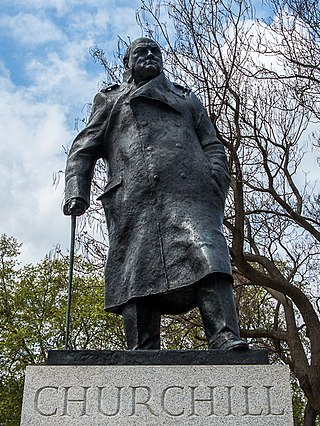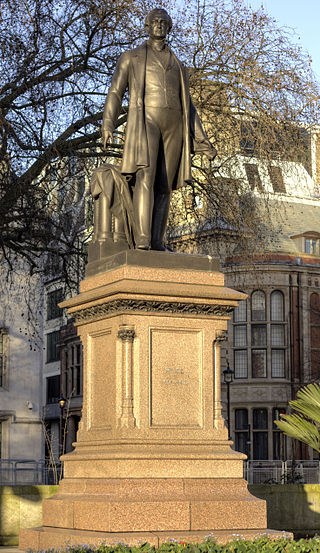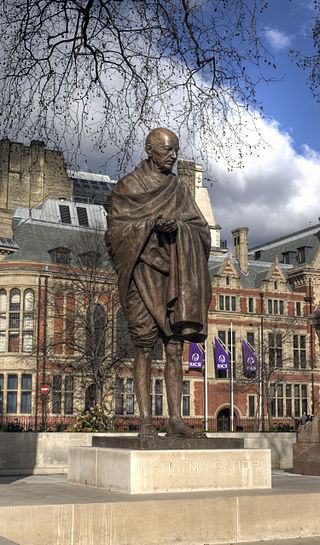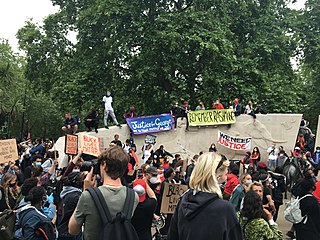
Parliament Square is a square at the northwest end of the Palace of Westminster in the City of Westminster in central London, England. Laid out in the 19th century, it features a large open green area in the centre with trees to its west, and it contains twelve statues of statesmen and other notable individuals.

František Bělský was a Czech-British sculptor.

Ivor Roberts-Jones was an English sculptor of Welsh descent on both his parents' sides. He is best known for his sculpted heads of notable people such as Yehudi Menuhin and George Thomas, Viscount Tonypandy.

Nelson Mandela is a bronze sculpture in Parliament Square, London, of former President of South Africa and anti-apartheid activist Nelson Mandela. Originally proposed to Mandela by Donald Woods in 2001, a fund was set up and led by Woods's wife and Richard Attenborough after the death of Woods. The then Mayor of London Ken Livingstone obtained permission from Westminster City Council to locate the statue on the north terrace of Trafalgar Square, but after an appeal it was located in Parliament Square instead where it was unveiled on 29 August 2007.

A bronze statue of Margaret Thatcher, the first female prime minister of the United Kingdom, stands in the Members' Lobby of the Houses of Parliament in London. It was commissioned in 2003 following a change in rules to allow the depiction of living prime ministers in Parliament under certain conditions. The bronze statue, sculpted by Antony Dufort, was unveiled on 21 February 2007 by Michael Martin, Speaker of the House of Commons, with Thatcher in attendance.

The Portrait of Winston Churchill was a painting by English artist Graham Sutherland that depicted the British prime minister Sir Winston Churchill, created in 1954. It was disliked by Churchill and within a year it had been destroyed.

The statue of Winston Churchill is a standing bronze statue of statesman and writer Winston Churchill, situated in the Members' Lobby of the House of Commons of the United Kingdom, part of the Palace of Westminster complex in Westminster, Central London. Churchill is depicted mid-stride, with his hands on his hips.

The statue of Robert Peel in Parliament Square, London, is a bronze sculpture of Sir Robert Peel, a former prime minister of the United Kingdom. It was sculpted by Matthew Noble and was one of the first three statues to be placed in the square.

The statue of Field Marshal The 1st Viscount Alanbrooke, by Ivor Roberts-Jones, was unveiled in Whitehall, London, in 1993.

The statue of Mahatma Gandhi in Parliament Square, Westminster, London, is a work by the sculptor Philip Jackson.

A life-size bronze statue of Jan Smuts by the British artist Jacob Epstein stands on the north side of Parliament Square in London, United Kingdom, between a statue of Lord Palmerston and a statue of David Lloyd George.

The statue of William Slim, 1st Viscount Slim in Whitehall, London, is a work of 1988–1993 by the sculptor Ivor Roberts-Jones. It is one of three memorials to British military leaders of World War II on Raleigh Green, outside the Ministry of Defence's Main Building, the others being Oscar Nemon's 1980 statue of Lord Montgomery and Roberts-Jones's statue of Lord Alanbrooke, erected later in 1993. Slim's bronze statue stands approximately 3 metres (9.8 ft) high on a pedestal of Portland stone.

The statue of Millicent Fawcett in Parliament Square, London, honours the British suffragist leader and social campaigner Dame Millicent Fawcett. It was made in 2018 by Gillian Wearing. Following a campaign and petition by the activist Caroline Criado Perez, the statue's creation was endorsed by both the Prime Minister of the United Kingdom, Theresa May, and the Mayor of London, Sadiq Khan. The statue, Parliament Square's first monument to a woman and also its first sculpture by a woman, was funded through the government's Centenary Fund, which marks 100 years since some women won the right to vote. The memorial was unveiled on 24 April 2018.

The bronze bust of former British prime minister Sir Winston Churchill at Mishkenot Sha’ananim, Jerusalem was created by portrait sculptor Oscar Nemon. Anthony Rosenfelder, together with MK Isaac Herzog, initiated the process of erecting the bust of Churchill in Jerusalem.

Throughout his life, Winston Churchill made numerous controversial statements on race, which some writers have described as racist. It is furthermore suggested that his personal views influenced important decisions he made throughout his political career, particularly relating to the British Empire, of which he was a staunch advocate and defender. In the 21st century, his views on race and empire are frequently discussed, and controversial, aspects of his legacy.

Protests were held across the United Kingdom following the murder of George Floyd, a 46-year-old African-American man, by a police officer in the United States on 25 May 2020. Immediately following his murder, protests and riots occurred in dozens of cities across the United States. Protests were staged internationally for the first time on 28 May, with a solidarity demonstration outside the United States Embassy in London. They took place during the UK COVID-19 pandemic.

A number of statues and memorials were the subject of protests and petitions during the George Floyd protests in the United Kingdom in 2020.

The statue of Winston Churchill in Woodford, London, is a bronze sculpture of the British statesman, created by David McFall in 1958–9. The statue commemorates Churchill's role as the member for the parliamentary constituency of Woodford. Churchill was elected to the Epping seat in 1924 and held it until 1945 when the new constituency of Woodford was created. Churchill then held this seat until his retirement in 1964. The statue is a Grade II listed structure.























